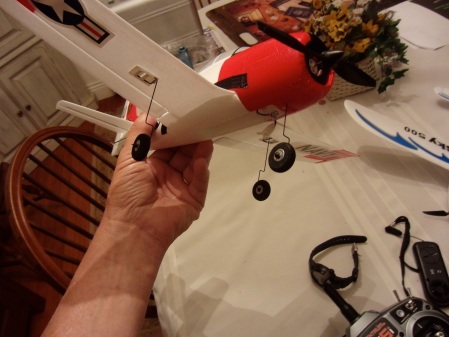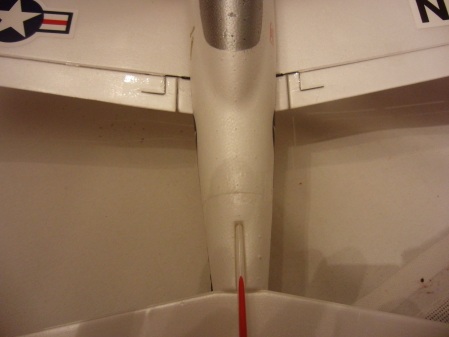
T-28 and the Sky 500 – very different. I used the transmitter that came with the Sky 500 for it, but the T-28 is now one of three planes binded (bound?) to the TX6i Spektrum transmitter.
This was one of those “breathe through your nose” moments. The good news is I went off to fly with two planes, flew through 2.5 batteries worth – and came back with two planes each looking as it did when it went out – and that despite the fact that one of them was brand new and uses ailerons – the T-28.
That said, flying the Sky 500 is an entirely different experience from flying the T-28. Both are tiny. The Sky 500 has a wingspan of 500mm – 10.6 inches. The T-28 is 4/5ths that at 16.5 inches. The flying weight is almost identical – 38 grams for the T-28 and 40 grams for the Sky 500. So both weigh less than two ounces and if you catch one in your hands as it glides in, the impact is next to nothing – feels like plucking a feather out of the air.
And I do that fairly frequently with the Sky 500, catching one wing tip as it glides by. I have nothing like that kind of confidence while flying the T-28. There I’m sitting onthe edge of the seat, trying to think one step ahead of this angry little hornet while my palms get sweaty – and I love it. I really do. The Sky 500 flies like a ballet dancer, with smooth, elegent, and not-too-fast turns and loops. The T-28 flies hot. After-all, it is a micro-version of a trainer used as the first step in preparing Navy pilots to fly the latest jets off carriers. (The full-sized plane was made by North American Aviation, designated the Trojan, and had an operational history that spanned three decades from 1950 to 1984. It was used as a trainer primarily by the Navy, Marine Corps, and Coast Guard – but also by the Air Force in its early days.) It’s wings show sharp edges – and it flies with sharp edges. But…. it can also fly calm and cool, as I soon discovered after it crashed almost instantly on the first attempt, then swung in a tight circle to buzz me on several following attempts. But once on my second battery – by this time I was no longer frantically dodging it on each toss – I felt I had tamed it through two actions:
- First, I simply slowed it down. It can fly real nice at roughly half throttle.
- Second, I took my hand off the right stick (aileron and elevator) and flew it mostly with the throttle and rudder. When it was at a comfortable altitude and I felt in control I started doing circles using only the ailerons – or a combination of aileron and rudder.
Flying this way I could sustain flights of several minutes without making a panic-stricken, crash landing. I came away from this intial experience absolutely thirsting for more. (I had plenty more in terms of charged batteries, but the sun had set and it was getting so the only way I could see the plane clearly was to get it above the tree line – and while it could get up there in the blink of any eye, I really preferred it a little closer to home.)

The landing gear is well-designed to click in place, but be easily removable if you want to fly on a grassy field and do belly landings.
I flew with the landing gear in place – though it can be quickly removed so it’s easy to toss the plane and do belly landings. Eventually I found a relatively smooth spot in the baseball infield near second base and did several take offs from the ground. I’m not sure these were actually scale take offs, but they seemed close to it and rising from the ground gave me more time to adjust to the unfamiliar controls. I also learned to cut the throttle and not give it too much elevator when, on one ROG take off it stood on its tail and clawed its way straight up. Twice when tossing it it did loops near the ground – totally unintentional, but an indicator of what I mean when I say it can fly hot.
The T-28 is advertised, incidentally, as an indoor flyer and I’m sure some people fly it indoors. At this stage in my skill development I can’t imagine such a thing. I doubt that it will handle much more than a 2-3 mph wind – but I want a lot more room to fly this than I can imagine in any indoor venue I’m likely to encounter. The original Air Force version, btw, had an 800 hp engine – the Navy version 1,450 hp! While there are other differences, that seems like a huge change in power and must have made for much different performance.
One aside – I have been trying to get the LiPo battery situation under control and I think am making serious progress. I now have an AC charger for the one-cellones I use most often on the Night Vapor, Champ, and T-28. I also have converted an eyepiece case so that the foam inserts allows me to keep the battery contacts away from one another while storing and/or transporting. The case is metal which I hope would be of some help in case of a battery fire. More on this in a separate post.
When I arrived at the field around 7 pm it was far more active than I had ever seen it. The small, western-most baseball field was being used by some version of a little league – the players looked very young – and the tennis courts were pretty packed. I’d rather fly when no one was around. But I felt confident enough with the Sky 500 to keep it well away from people and well under control in the near calm conditions. And I did. I simply used the eastern half of the playing field that had no one on it and I kept well away from the tennis courts. The result was a relaxing dream flight – or series of flights – that lasted a total of 18 minutes with occasional, brief stops on the ground – landings that were really catches. Much of that time I flew at half throttle – sometimes gunning it to gain altitude and some times cutting the engine entirely and gliding a bit – and that’s what this plane does – it glides. That is, it coasts downhill – it does not behave like a sail plane. I have yet to see it catch some lift after the engine has been cut. But that’s OK. Flying it was a relaxing warm-up.
Then I put the Sky 500 back in the car, took a deep breath, and put a battery in the T-28. This was my second attempt at flying with ailerons. I had used them with the Sky Surfer. But that plane has a different feel to it and there were no crowds around for me to send an out-of-control airplane careening into. I should hasten to add that in this case there were tall wire backstops between me and the baseball players and fans and the tennis courts are also surrounded by high wire. I made up my mind to keep all my flying well away from these areas and to cut the engine, dive and crash if the plane started heading that way. It never did.
What was most bothersome was the plane wanted to go into a tight left circle as soon as I tossed it. In My first toss I used full throttle. But I quickly found that wasn’t necessary and I started using something closer to half throttle. Even at that speed, though, I was still dodging the plane, then fighting to gain control. I thought this was due to a tab setting. I’m still not sure. I made adjustments, I started doing ROG take-offs, and things eventually settled down.
This little dude is tough. The light weight, fortunately also means light impacts – and I seem to be learning how to avoid the worst of crashes so what I experienced were more like bad landings than crashes. In any event, it absorbed the impacts with no complaints.
Bottom line. I love both these planes. Damn this is fun!
T-28
Wingspan: 16.5 in (419.1mm)
Overall Length: 13.6 in (346.1mm)
Overall Length: 355mm
Flying Weight: 40g
Motor: Micro Coreless Motor
ESC: All in one ESC/RX/Linear Servos
Battery: 3.7V 150mAh Lipoly (required)
18 minutes – gand catches 0 leisurely loverly flying 500
t-28, crash – dodge -crash, circle left -wheels up landing at second base – takeoffs from infield – use just rudder and throttle – slow flying – lose sight unless above trees (twilight)






 Posted by Greg Stone
Posted by Greg Stone